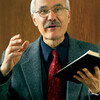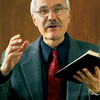“I pray that you might be active in sharing your faith, so that you will have a full understanding of every good thing we have in Christ” (Philemon 1:6, NIV).
Who is the most effective evangelist in the world? When I ask that question, I usually get the same predictable answers: Doug Batchelor, Carlton Bird, Mark Finley, Alejandro Bullón, Dwight Nelson, Kenneth Cox, etc. When I ask how people come to the Lord and the church, I get wildly different answers.
Consider the following list. What percentage of people come to the Lord and into church fellowship as the result of one of the following approaches?
- Special needs (such as illness, divorce, loneliness, lose of a job, etc.)
- Walk-ins (people who live nearby and visit uninvited)
- A connection with the pastor
- Door-to-door visitation
- Sabbath school
- Public evangelistic meetings
- Church programs (health seminars, VBS, school, Pathfinders, etc.)
Most people say that 90% of people come to church because of felt needs. Others insist visitation accounts for 60% of decisions. Still others say the pastor brings in at least 40–60%. Some people feel that public evangelism produces 50–90% of all converts.
So what is the answer? Who is the most effective evangelist in the world? The research may surprise you.
The Facts Speak for Themselves
I’ve carefully researched this issue to determine what brings the most people to Christ and into a faith community. When I share the results with people, they are shocked. In fact, most people start questioning the findings. I hear things like, “This cannot be true. Felt needs is how people come to the Lord.”
Others say, “No, no, public evangelism is how people accept Jesus.” Another group insists the pastor and church programs are what really work.
Here are the facts. Research shows that the influence of moms and dads, friends or relatives, neighbors, or co-workers usually accounts for between 70–95% of decisions.
- Special needs: 2%–5%
- Walk-in: 2%–5%
- Pastor: 2%–5%
- Visitation: 2%–5%
- Sabbath school: 2%–5%
- Evangelistic series: 2%–5%
- Friends/relatives: 70%–95%
These results shock and surprise people at first. Then they start to reflect and experience that “aha!” moment. They start saying, “Well, yes, my mom had the most influence on my religious experience,” or “My neighbor took me to Sabbath school when I was a little girl.”
Another person might add, “My grandmother was an Adventist, and she prayed for me for years. Finally, I decided to take God seriously.” Someone else remembers it was a co-worker who invited him to church so many years ago.
The most effective evangelist in the world is the one who takes personal interest in us and shares Jesus in a holistic and attractive way. So I repeat my question: Who is the most effective evangelist in the world? You are the most effective evangelist in the world.
What About Adventist Research?
In the autumn of 2004 a survey went to a sample of Seventh-day Adventist congregations in the North American Division to be given to attending members on a certain Sabbath. The purpose of the survey was to discover their devotional and evangelistic practices. How do Adventist Christians fare in evangelism? The 1,689 surveys told us. The key features of the data appear below. We need to pay attention to the information given to us by these 1,689 Adventists, because if we can understand what is happening and why, then we can improve the way we do church and the manner that we reach out to people in Jesus’ name.
How They Joined?
A topic of special interest included in the 2004 survey was a question asking the relative strength of nine factors in influencing the respondents to join the Adventist church. Below is the result.
Since that time, I have repeated this survey with large and small gathering of people as I conduct my seminars all across the world. The groups range in size anywhere from 100 people to more than a thousand people. The result is always the same. The vast majority of people who come to Jesus come through loving relationships.
How People Join the Church
- Brought up in an Adventist home: 59%
- A friend or relative: 58%
- Read books, journals, other material: 49%
- Public evangelism meetings: 36%
- Bible studies in the home: 34%
- Visits by a pastor: 20%
- Television or radio programs: 20%
- Bible correspondence course: 19%
- Material on the internet: 7%
- Others: 22%
The Adventist study is consistent with all similar research. Win Arn1 and Thom Rainer2 both agree that friendship is God’s preferred means of reaching people. And the implications are universal in its scope. I travel all over the world, training people in evangelism and church growth. Remarkably, whether I am in Asia or Africa, North America, Central America, South America, Europe or Australia, the results are the same. Most people come to the Lord through the influence of a web of relationships and friendships.
The absolutely most effective way of reaching people for the gospel is through personal influence. So what does God do? For example, how does He reach police officers? By disguising full-time ministers as police officers. Giving them the necessary gifts, passions and credentials, He assigns them to police departments all over the nation. The same for construction workers.
Again, after camouflaging full-time ministers as construction workers, He endows them with gifts and passions, makes them strong, and puts them to work at construction sites throughout every city. God’s full-time ministers are everywhere: in classrooms and clinics, holding hammers and stethoscopes, in front of shareholders and behind the auditor’s desk. We are all ambassadors of the gospel — we are all full-time ministers.
So in every city, every town and every country, you will find there full-time ministers, differently made and differently gifted, in every business and vocation. Like salt from a saltshaker, God scatters us everywhere to suit His flavor. He salts the earth with His ministers, providing them with gifts to enable them to influence their friends, families and co-workers.
How Do You Do It?
Here is an easy and practical 10-step strategy to help you win others to Christ.
- Intentionally build relationships with five people every year. They should be individuals within your circle of regular contact — far better your nearby relative, friend, co-worker or neighbor than your dear old aunt across the country.
- Pray for them every day, asking God to intervene in their lives and to lead them to Himself. Ask the Lord to keep you faithful in your intercessory prayer and passionate about reaching them with the gospel.
- Minister to their needs: physical, spiritual and social. Take the time to be a true friend. Make them feel loved and special.
- Share your values with them, such as why you do certain things and why you don’t do others, and always link everything to Jesus. Help them see that the Christian faith is not a set of rules, but a relationship with a wonderful God.
- At the right time offer your testimony with them. Tell them how much Jesus changed your life and how much He means to you. There is perhaps no evidence more persuasive than this.
- Introduce them to Jesus. Tell them His story and how He is the hope of the world and the only way to God. Give them a gospel presentation.
- At the appropriate time invite them to church, a concert, a special program such as Easter or Christmas, an evangelistic meeting, a small group (it would be great to start one in your home), a Sabbath School class or anything else that you may think of. This will ease them into church life and help connect them with other Adventist Christians.
- Study the Bible with them so they can understand the Christian faith and what it means to be a Seventh-day Adventist Christian.
- Nurture the new believer. Disciple them. Help them to grow in the Christian faith. Become their pastor and encourager.
- Teach them to reach others. Reproduction is essential to the work of God.
One day you will be walking on the streets of gold holding the hand of Jesus, and someone will come to you and say, “I am here because of you.” That is worth all the investment you put into people.
The Power of Relationship and Personal Touch
Judy, a single mom in her mid-20s, came with her 5-year-old daughter to our church as a result of an invitation by one of our members to attend an evangelistic meeting. The young woman was eager to question everything and learn. Although she grew up Baptist, she left the church when she was 18 years old and became involved in some drugs, heavy drinking and heavy partying. A one-night stand left her pregnant. The pregnancy woke her up. Although she started to work on improving her life, she did not meet with much success, often relapsing into her old ways.
When Judy moved to our area she ended up living next to Donna, an authentic Christian woman from our church. Donna took the time to build a relationship with Judy, often going out of her way to meet her needs. For example, Donna spent hours listening to Judy and doing everything she could to help her escape her bouts of depression.
Our church was in the habit of having one evangelistic meeting every winter. That particular winter, Judy was going through a very difficult time. Donna invited her to attend.
Judy learned for the first time how special she was in the sight of God. She experienced God’s presence and eventually asked for His grace and power. The power of His love transformed her. She asked many questions to learn everything she could about God. Several times after her baptism, Judy faced many challenges to her newfound faith, but the relationship she had with Donna and other new friends in the church kept her strong and growing in the Lord.
Her story illustrates the power of combining personal evangelism with public evangelism. Here we see the importance of building relationships and of thorough follow-up. Judy did not have a dramatic Damascus Road experience as did Paul, but she had an invitation to hear the gospel followed by a thorough process of discipleship that met her spiritual as well as emotional needs.
As a pastor I always visited the people I baptized the day after their baptism to encourage them and to recast the vision for evangelism and ministry for them. Judy was working as a manager in a grocery store when I stopped by. We walked around, and then I said to her, “Judy, let’s pray and dedicate this grocery store as your place of ministry.”
As I started to leave with her after finishing the prayer, I noticed one of the cashiers who seemed to know Judy quite well. So I asked Judy about the woman. “That’s Mary-Lin, a close friend of mine,” she explained.
“God has a mandate for you to win Mary-Lin to Him, Judy,” I told her. “Pray for her. Build your relationship with her. Love her.”
And that is exactly what Judy did. She loved her, prayed for her, and built a closer relationship with her.
The first thing she did was to invite Mary-Lin over to her house for supper on Friday night. Judy was on fire for God. Her excitement and changed life led Mary-Lin to the Lord. The two women started to study the Bible every Friday night. About two months later Mary-Lin was standing in the waters of baptism, giving a heartfelt testimony about how her friendship with Judy had made a powerful impact on her and brought her to Jesus.
Wow — the power of relationship. You can be a Donna to a Judy in your life. In fact, you can be the most effective evangelist in the world! Is there any good reason not to start today?
Nurturing the New Believer
The new believer in Jesus has just experienced the most radical transformation in their orientation to life, their social circle, their habits, their choices and their lifestyle. New Seventh-day Adventists have remapped their weekly calendars, reexamined their dinner plates, realigned themselves with biblical revelation and made many other major adjustments.
Such fledgling members now need a care that extends beyond giving them a towel to dry off after the baptism. They need to be nurtured and discipled, to be accepted by a new church family and provided protection from attacks outside the church and from problems inside it. The following four categories illustrate one way to visualize the basic requirements of the new member:4
- The new faith must be strengthened.
- New friends must be made.
- New fellowship must be provided.
- A place or role to function in ministry as part of church life must be nurtured.
Strengthening the New Faith
Faith develops as the individual’s walk with God continues and as he or she gain confidence in their new church family. Always the result of interpersonal experience, it grows best in the context of a faith community. In other words, you can help the new members’ faith expand and mature by sharing your personal walk with God, modeling the Christian life and helping them learn to feed themselves spiritually.
Making New Friends
Do not underestimate this important step — it is a critical component of discipleship. In fact, the number of friends that a person has in the church has a direct correlation with the likelihood that they will remain a member in that community. It also offers a tremendous opportunity to members who may not feel very comfortable giving a formal Bible study — they can minister by making friends! Friendships develop as we take time to listen to each other and spend time together. Inviting new members home to dinner or out to the park or to some social activity with other believers are only some of the many ways that you can nurture them.
Providing Fellowship
The secular definition of fellowship is a friendly association of people who share the same interests, a group working toward a common goal, a feeling of friendship or relatedness or connection between people. In the Christian sense fellowship may be described as the atmosphere of the Sabbath school or potluck meal or even the worship hour.
A person may have friends in the church, but is he or she comfortable going to a church function with several people? Do they feel that they connect with them or have something in common? Do they share the same interests or values? Taking the time to be a part of a fellowship group that focuses on spiritual growth or ministry (or both) is another way of helping the new member be a part of church life.
Finding a Place in Ministry
The sense of being needed by the church family will do much to help that new member feel they belong. Assist them to find an area of ministry that fits their personality and spiritual gifts. See that they get the training they must have to succeed. By doing this you are discipling the new member, fulfilling the needs of the church, and accomplishing the gospel mission.










